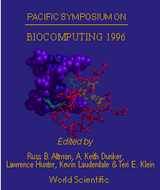Assessing the performance of fold recognition methods by means of a comprehensive benchmark
Fischer D, Elofsson A, Rice D, Eisenberg D
UCLA-DOE Lab. of Structural Biology & Molecular Medicine, Molecular Biology Institute 90095-1570, USA.
Pac Symp Biocomput. 1996;:300-18.

Abstract
Recently there has been an explosion of methods for fold recognition. These methods seek to align a protein sequence to a three-dimensional structure and measure the compatibility of the sequence to the structure. In this work, we present a benchmark to assess the performance of such methods. The benchmark consists of a set of protein sequences matched by superposition to known structures. This set covers a wide range of protein families, and includes matching proteins with insignificant sequence similarity. To demonstrate the usefulness of this benchmark, we apply it here to compare different fold-recognition methods developed through the years in our group as well as several sequence-sequence substitution matrices. The results show that "global-local" alignments are superior to either local or global alignments. The most effective sequence-sequence matching matrix is the Gonnet table. The best performance overall is obtained by a method which combines the 3D-1D profiles of Bowie et al. with a substitution matrix and takes into account residue pairwise interactions.
[Full-Text PDF] [PSB Home Page]